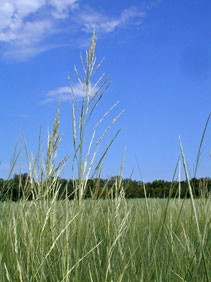PRAIRIE SANDREED
|
 |
| File Size: 83 KB |
|
|
|
Calamovilfa longifolia (Hook. ) Scribn.
|
| Riley County, Kansas |
| Perennial |
| Height: 1.5-6 feet |
| Family: Poaceae - Grass Family |
| Flowering Period: July, August, September |
|
| Culms: | | Erect, usually solitary, stout, solid or hollow near base, glabrous, waxy. | | Blades: | | Flat near base but rolling inward near thead-like tip, 4 to 24 inches long, 1/6 to 1/3 inch wide near base, slightly rough. | | Sheaths: | | Open, crowded, overlapping, mostly glabrous but often hairy on margins at collar; no auricles. | | Ligules: | | Short, dense fringe of hairs. | | Inflorescences: | | Panicle, mostly narrow to loosely spreading, 4 to 16 inches long; branches slender, erect or ascending, smooth; lower branches 4 to 5 inches long. | | Spikelets: | | Flattened, about 1/4 inch long, 1-flowered, crowded; glumes unequal, 1/4 to 1/3 inch long, 1-nerved, rigid, papery; tips pointed; lemmas 1-nerved, glabrous, conspicuous tuft of long hairs at base; awns absent. | | Habitat: | | Sandy habitats; sandhills, sand prairies, loose sandy slopes. | | Distribution: | | Primarily north 1/2 of Kansas. | | Forage Value: | | Though coarse and not particularly palatable, livestock will consume the early growth. It will disappear under heavy grazing. | | Uses: | | The Lakota wore the inflorescence on their heads as a war charm instead of feathers and used it to clean their pipes. | | Comments: | | Prairie sandreed spreads quickly via rhizomes and seed, making it an excellent sandbinding grass. It is sometimes used to stabilize blowout areas. |
|
| Prairie sandreed |  | | 152 KB | | Riley County, Kansas |
| | Prairie sandreed inflorescence |  | | 106 KB | | Riley County, Kansas |
| | Prairie sandreed spikelets |  | | 75 KB | | Riley County, Kansas |
| | Prairie sandreed blades |  | | 155 KB | | Riley County, Kansas |
| | Prairie sandreed ligule |  | | 54 KB | | Riley County, Kansas |
| |
|
|
|
|
|
|